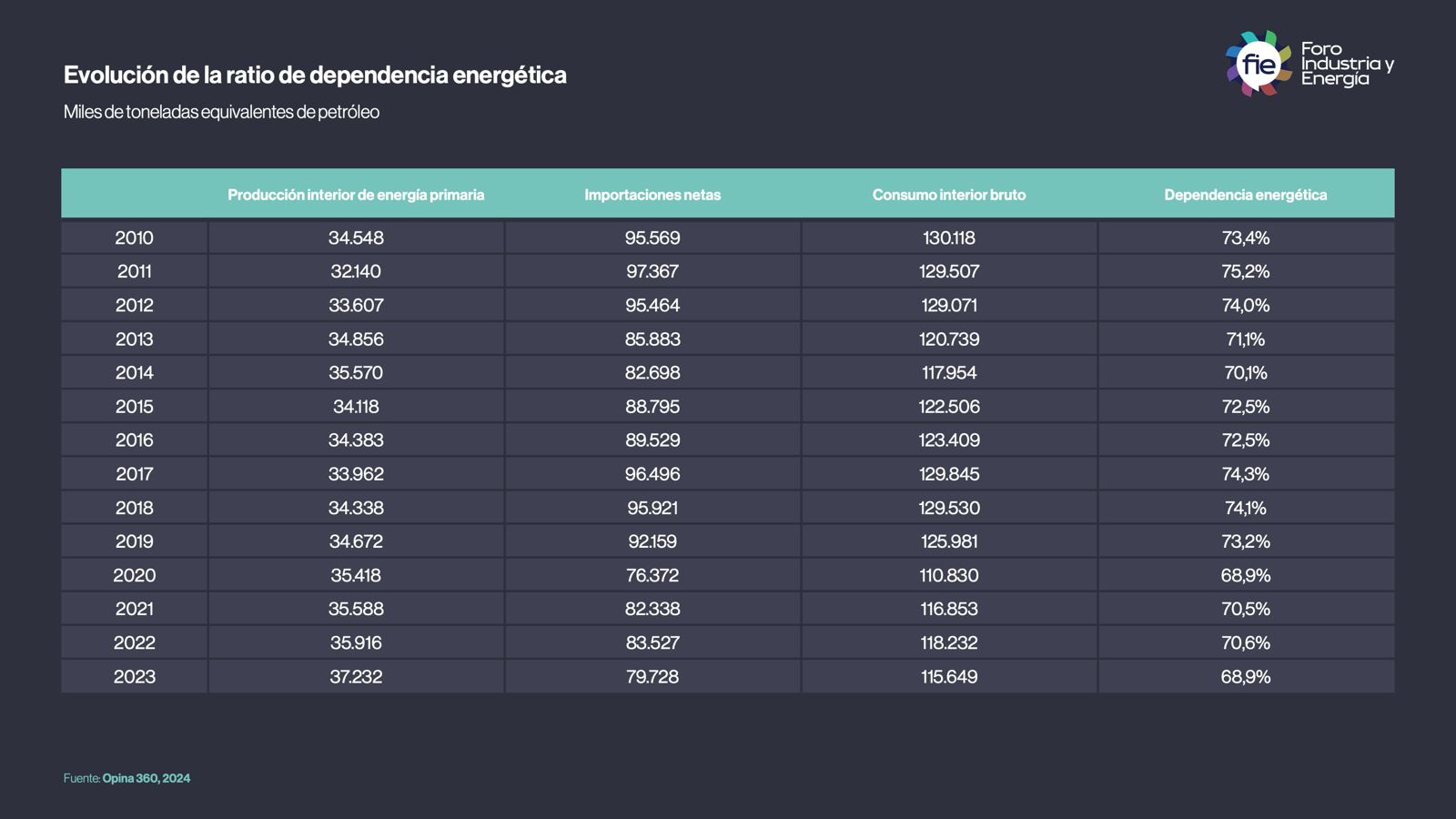-
Spain’s energy dependence level in 2023 stood at 66.8%, almost two percentage points lower than in 2022.
-
This decrease is attributed to a combination of an increase in domestic primary energy production (3.7%) and a reduction in gross energy consumption (-2.2%).
-
To achieve the target of 50% energy dependence by 2030, as established in the PNIEC, gross domestic energy consumption would need to decrease by 10% compared to 2023, and the contribution of renewable energy would need to nearly double.
-
2023 marked a record year for Spain in terms of domestic energy production: one-third of the energy consumed (33.2%) was produced locally.
-
Of this domestic production, 58.9% came from renewable sources, and 39.7% was generated from nuclear energy.
Madrid, December 12, 2024. Spain achieved its lowest level of energy dependence on foreign sources in 2023, according to an analysis by Foro Industria y Energía (FIE) and Opina 360 based on data from MITECO. The energy dependence ratio was recorded at 66.8%, down from 70.6% in 2022, driven by an increase in domestic primary energy production (3.7%) and, more notably, a reduction in net energy imports (-4.7%). In fact, this was the year with the lowest net energy imports this century, excluding the exceptional year of 2020 due to the pandemic.
This decline in external energy demand was not only influenced by higher domestic production but also by a significant reduction in gross domestic consumption, which fell to 115.6 million tonnes of oil equivalent (-2.2%). This represents the lowest consumption figure since 2000 (also excluding 2020).
On the other hand, the increase in domestic primary energy production experienced a substantial boost, reaching a record 37.2 million tonnes of oil equivalent. This achievement is largely attributed to renewable energies, whose output rose by 9% to a historic high of 21.9 million tonnes of oil equivalent. Renewables now account for 58.9% of all domestic energy production. Among these, growth was particularly driven by photovoltaic energy (38% increase over the past year) and hydropower (42.3% increase). However, within the renewables sector, wind energy and biomass remain the leading contributors. Beyond renewables, the other major source of domestic energy is nuclear, which contributed 39.7% of total national production.
According to experts from Foro Industria y Energía, the reduction in energy dependence may also be linked to lower industrial demand, driven both by increased energy efficiency and, especially, the impact of self-consumption.
Is It Possible to Reach 50% Dependence by 2030 as the PNIEC Envisions?
An analysis of data from the past two decades shows that gross domestic energy consumption has decreased by 6.8% since 2000, despite a 41.2% increase in GDP. During this period, the decline in net energy imports has been even more pronounced (-14%), as a significant portion of national energy consumption has been offset by higher domestic production, which has increased by 18.9% over the same timeframe.

At her inauguration, the new Minister for Ecological Transition, Sara Aagesen, highlighted that the PNIEC’s objectives include achieving 50% energy dependence by 2030. The PNIEC bases this target on an increase in domestic production, particularly from renewable energy sources, and a significant reduction in total energy consumption, which would need to decrease to 104 million tonnes of oil equivalent.
According to data from Foro Industria y Energía and Opina 360, to reach this goal, total energy consumption would need to be reduced by 10.1% compared to 2023, and the contribution of renewables would need to nearly double (90.9%). This is especially crucial given that, with the planned closure of certain plants, the contribution of nuclear energy is expected to decrease by 38%.

